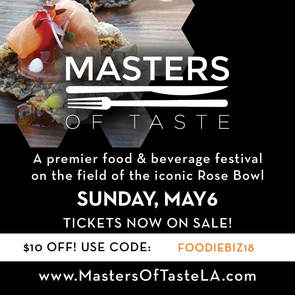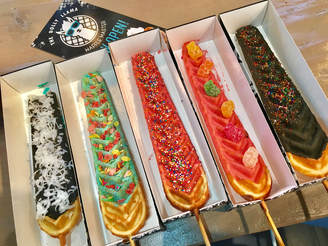 Masters of Taste is set to take place at The Rose Bowl on Sunday, May 6. This annual collection of culinary bliss brings together some of LA’s top restaurants, as well as wineries and drink purveyors from across California. It’s not often that you get the chance to walk on the field in the Rose Bowl, let alone do so in the context of a food festival. The event gets even better with $10 off. Just enter the code FOODIEBIZ18 at checkout to receive your discount. Featured culinary Masters include Chefs Kyle Johnson (Bourbon Steak), Jose Acevedo (Mercado), Alex Sarkissian (Moment), Ted Hopson (The Bellwether), Tim Guiltinan (The Raymond) and many others. Beverage Masters include Riboli Family Wines, Kieu Hoang Winery, Angel City Brewery, Dulce Vide Tequila and more. And don’t forget dessert—Sweet masters include Kristine De La Cruz (Crème Caramel LA), Sasha Gustafson (Butter Cake Shoppe) and Maria Agnese (Fatamorgana Gelato) among others. For more information and to book tickets, visit Masters of Taste online.
1 Comment
 Instagram has transformed photos as a means of communication, with food ranking high among Instagram’s content leaderboard. Many restaurants have upped their food presentation to make their product more ‘sharable’ on social media, but some places have gone a step further. Popping up more and more are socially-built restaurants—mostly dessert-focused eateries that were literally built for Instagram. How exactly can a restaurant be built for Instagram? Simple: 1. Create visually stunning food and backdrops that encourage guests to share photos of your food with their friends. 2. Reap the rewards of free marketing when those friends come in through your doors, buy your product, photograph it and share it with their friends. 3. Repeat steps 1 and 2 as the cycle continues. Your food, while serving as the financial crux of your business, takes a back seat to the social sharing experience. Thinking about it from a business perspective, the move makes a great degree of sense. Here’s why: Dessert is a natural haven for photogenic, brightly-colored food Sprinkles, M&M’s and cotton candy are among the most visually interesting edible items on camera. Preparing a burger with fresh meat, cheese and produce to produce the savory equivalent of such vibrant colors is a complex, costly undertaking by comparison. Dessert contains numerous color contrasts—chocolate and vanilla, vanilla raspberry, vanilla and caramel, etc.—as well as a multitude of unnaturally-colored products that are accepted by society as being perfectly good things to eat. Try selling a burger with bright green meat and pink buns! Dessert is low-cost and high-margin Desserts entail significantly lower ingredient and production costs than most of their savory counterparts, affording them lower price points to appeal to the masses and the target demographics that naturally share their food on social media. "Making eye-catching dessert is the first step. Just as critical is informing audience members where they can go to get the same experience." Dessert establishments are prone to higher traffic and turnover in smaller spaces
A dessert-only restaurant will feature far fewer traditional booths and tables, and skew more toward long, narrow countertops and shared tables designed for groups to congregate, eat and leave. Dessert doesn’t take as long as a normal meal [unless you have a serious sweet tooth!], again lowering the barrier to entry by posing a minimal time commitment on top of the lower price. With higher turnover and lots of to-go business, as well as fewer kitchen and inventory requirements, dessert establishments can afford to be significantly smaller than standard restaurants while still attracting significant traffic. This opens the gates to a larger group of budding restaurateurs that wouldn’t be as prone to investing in a large amount of real estate. There are many more built-in features that make dessert a natural candidate for socially-built restaurants, but these don’t guarantee success. So, what are successful establishments doing to stand out? Making big, killer products Look at any of the socially-built dessert hotspots and you will likely see enormous scoops of ice cream with generously-poured toppings [at least they look generous] and other accouterments sticking out the top and flowing from the sides of the cone, cookies or other vehicle. And yes, it tastes as good as it looks. Bigger is better for these places. CREAM, short for Cookies Rule Everything Around Me, is a prime example of socially-built massive desserts that appeal to the eye and the palate alike. No expense is spared, because their food costs double as the marketing budget. Designing a restaurant full of Instagram backgrounds Making eye-catching dessert is the first step. Just as critical is informing audience members where they can go to get the same experience. The Dolly Llama in Downtown Los Angeles has this practice down pat. Every part of this small restaurant is an Instagram backdrop, complete with bright neon lighting and their hashtag splayed across the wall. Creating a social atmosphere Snapping food photos is always a toss-up. Some love to do it, some hate when it’s done, and some love to do it even when around those who hate when it’s done. In any case, successful socially-built establishments will push an energetic atmosphere that drives social interaction and consequent phone use. Music, board and lawn games and other forms of entertainment will push guests to engage in the ‘free’ marketing practices sought by these places. |
AuthorBenjamin Brown is a seasoned restaurant writer and hospitality consultant, serving up SoCal's hottest food news and reviews. Categories
All
Archives
June 2021
@Foodie_Biz |
|
Home
About
Blog
Consulting Tips
Contact
Legal
|
Foodie Biz provides restaurant news and reviews for the food community, as well as consulting advice for restaurant owners and other hospitality professionals.
Contact Foodie Biz for media opportunities and freelance consulting projects. Contact Foodie Biz |



